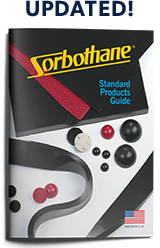What’s a Good Vibration Damping Material for Cameras?
Explore camera related vibration issues.
-
- Cameras contain optics and electronics. These sensitive structures are susceptible to damage when exposed to vibration. Such exposure can occur during operation, storage, or shipping.
-
- Vibration exposure while operating the camera can result in poor output quality regarding photography and videography.
-
- To address these vibration-related issues, you must ask—What’s a good vibration damping material for cameras? The answer—Sorbothane®—the best vibration energy damper available.
Use vibration damping to protect your cameras.
-
- Vibration is actually an oscillating energy. It is comprised of forces that repeat in a cyclical pattern. These forces transfer waves of energy to camera equipment at the point of impact. These energy waves are defined by their amplitude (strength) and frequency (number of energy wave cycles per unit time). The transfer of this energy to the camera results in the familiar manifestation of vibration—a back-and-forth or up-and-down motion. To protect the camera and the integrity of its output, both frequency and amplitude of vibration must be controlled. This control is derived from the use of a superior vibration damper—Sorbothane.
-
- Vibrations that are higher in amplitude are capable of causing more damage. Sorbothane will effectively absorb this energy and safely dissipate it as heat.
-
- The frequency associated with the vibration must also be controlled. Frequencies can affect objects, such as cameras and camera components, differently. Every material, system, or object has a natural (resonance) frequency. When conditions exist, so that the resonance frequency of the camera or its components matches that of the source of vibration, the camera/component will begin to resonate. When this occurs, the energy waves stack on top of one another—creating a vibration energy wave with an amplitude that is continuously increasing in strength. In this manner, lower amplitude vibration will increase in strength by feeding on the lower level of energy being supplied. These undesirable resonance frequencies can be kept under control with Sorbothane—a good vibration damping material for camera equipment.
What is Sorbothane and how does it function in vibration damping?
-
- Sorbothane, a uniquely formulated viscoelastic material, acts as a liquid and as a solid.
-
- Under impact of vibration energy, this proprietary polymer will flow like a viscous liquid.
-
- Sorbothane will revert to its original shape upon removal of the vibration energy source. In this role of elastic solid, this polymer displays superior memory.
-
- Sorbothane possesses an excellent damping coefficient. Consequently, it demonstrates superior absorption of vibration energy, accompanied by its safe release—dissipation as heat, outward from the source of vibration impact.
Use Sorbothane damping products to protect your cameras.
What’s a good vibration damping material for cameras? Sorbothane—with its ability to be cast in any thickness, shape, or size, renders it the perfect damper to incorporate into your camera design. Our skilled engineers will work with you to achieve your optimum design. Sorbothane mounts isolate your camera equipment from vibration—improving the quality of your pictures and videography. Sorbothane pallet mounts, anti-vibration blankets, strips, and our solid, dimpled, and honeycomb sheets, are useful in controlling vibration during shipment.
Contact us.
Contact Sorbothane to discuss your specific vibration damping needs.
